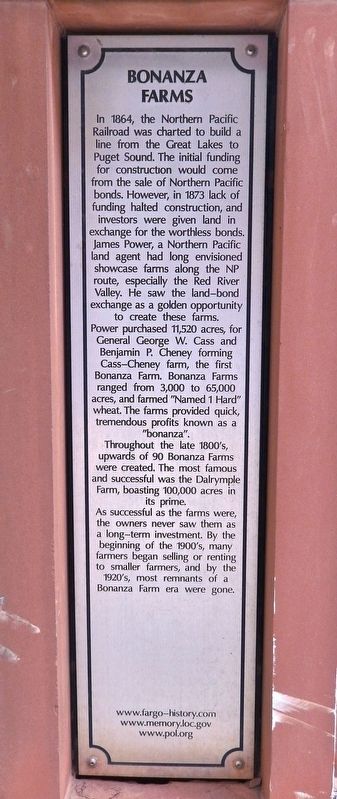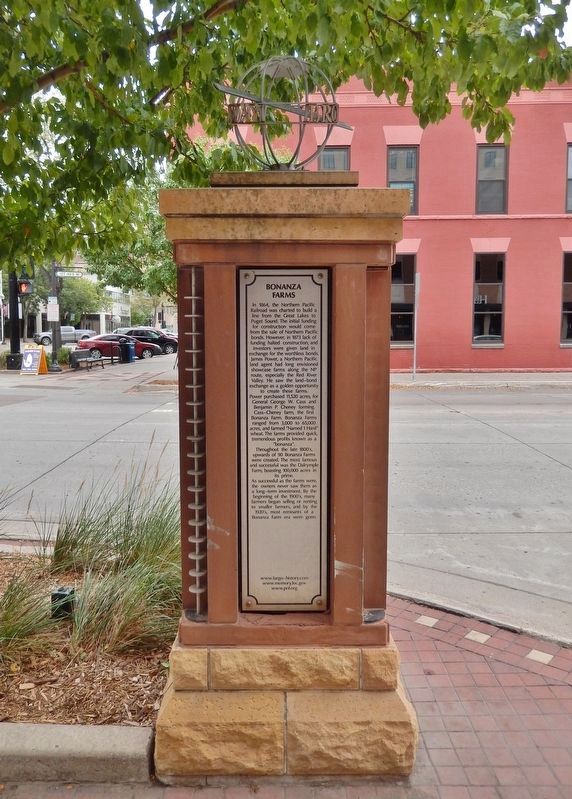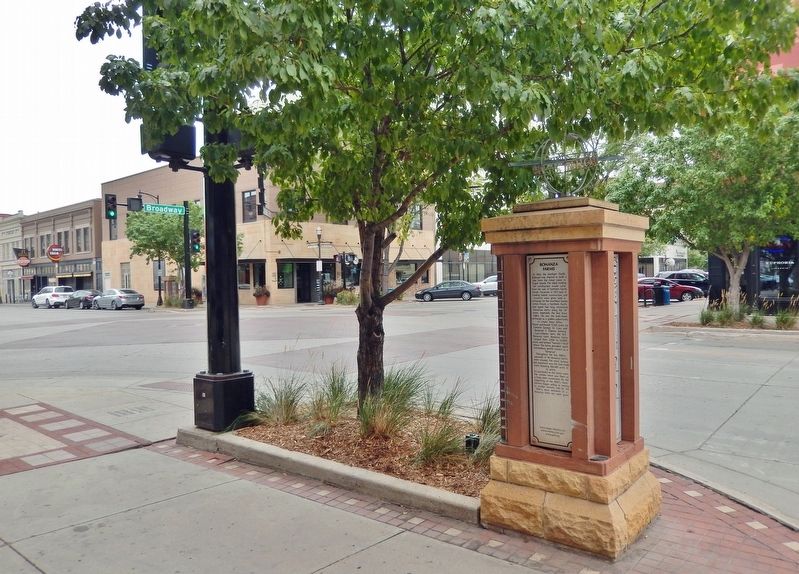Downtown in Fargo in Cass County, North Dakota — The American Midwest (Upper Plains)
Bonanza Farms
Power purchased 11,520 acres, for General George W. Cass and Benjamin P. Cheney forming Cass—Cheney farm, the first Bonanza Farm. Bonanza Farms ranged from 3,000 to 65,000 acres, and farmed "Named 1 Hard" wheat. The farms provided quick, tremendous profits known as a "bonanza".
Throughout the late 1800's, upwards of 90 Bonanza Farms were created. The most famous and successful was the Dalrymple Farm, boasting 100,000 acres in its prime.
As successful as the farms were, the owners never saw them as a long-term investment. By the beginning of the 1900's, many farmers began selling or renting to smaller farmers, and by the 1920's, most remnants of a Bonanza Farm era were gone.
Topics. This historical marker is listed in these topic lists: Agriculture • Industry & Commerce • Railroads & Streetcars • Settlements & Settlers. A significant historical year for this entry is 1864.
Location. 46° 52.622′ N, 96° 47.275′ W. Marker is in Fargo, North Dakota, in Cass County. It is in Downtown. Marker is at the intersection of 1st Avenue North and Broadway North, on the left when traveling east on 1st Avenue North. The marker is located along the sidewalk near the northwest corner of the intersection. Touch for map. Marker is at or near this postal address: 102 Broadway North, Fargo ND 58102, United States of America. Touch for directions.
Other nearby markers. At least 8 other markers are within walking distance of this marker. Plains Art Museum (a few steps from this marker); Red River Valley Crops (a few steps from this marker); NDSU Agriculture (within shouting distance of this marker); City Hall & Library (within shouting distance of this marker); Machinery Row (within shouting distance of this marker); Osco Drug (about 300 feet away, measured in a direct line); Wildlife in the Red River Valley (about 300 feet away); Recreation on the Red River (about 300 feet away). Touch for a list and map of all markers in Fargo.
Also see . . .
1. Bonanza farms (Wikipedia). Excerpt:
Bonanza farms were very large farms established in the western United States during the late nineteenth century. They conducted large-scale operations, mostly cultivating and harvesting wheat. Bonanza farms developed as a result of a number of factors, including the efficient new machinery of the 1870s, cheap abundant land available during that period, the growth of eastern markets in the U.S., and completion of most major railroads between the farming areas and markets. Bonanza farms were encouraged by John Wesley Powell who, by the 1870s, had found that the land he studied needed larger-scale irrigation systems that would lead to larger areas of land being taken care of. Powell, a geologist, asserted that family-owned farms that had been in use in accordance with the Homestead Act of 1862 did not quite give the land the type of help required to keep it fit.(Submitted on January 28, 2024, by Cosmos Mariner of Cape Canaveral, Florida.)
2. Bonanza Farms, Red River Valley. Excerpt:
Railroads had a significant impact on agricultural development in the Red River Valley. Trains provided transportation for the newcomers and carried equipment and supplies needed for farming. Railroad companies received large land grants to build their rail lines. One of the railroads, the Northern Pacific (NP), went into bankruptcy in 1873. The NP's board of directors agreed to exchange the railroad's worthless bonds for land at face value. This enabled investors to purchase large tracts of land for just fifteen cents per acre. Among the first to take advantage of the offer of land at discounted prices were General George W. Cass, president of the NP, and Benjamin Cheney, a member of the railroad's board of directors. Cass and Cheney initially purchased 13,440 acres a few miles west of Fargo in 1874.(Submitted on January 28, 2024, by Cosmos Mariner of Cape Canaveral, Florida.)
3. Dalrymple Farm. Excerpts:
Oliver Dalrymple had become known as the Minnesota wheat king with his large wheat farming operation near Cottage Grove in Washington County, Minnesota. Unfortunately, he lost his farming profits by speculating in the grain trade. General George Cass had come to know Dalrymple during his "wheat king" days as a good farmer who used the most advanced farming techniques. Cass and Cheney hired Dalrymple to manage their new farmland. As a land speculator, Dalrymple was as enormously successful as he was as a farmer. The Dalrymple land, near Fargo and the Northern Pacific mainline, saw a rapid increase in price. Dalrymple, who bought land in 1876 and after for prices ranging from 40˘ to $5 per acre found his land worth $20-$25 per acre by 1884.(Submitted on January 28, 2024, by Cosmos Mariner of Cape Canaveral, Florida.)
Credits. This page was last revised on January 28, 2024. It was originally submitted on January 28, 2024, by Cosmos Mariner of Cape Canaveral, Florida. This page has been viewed 63 times since then. Photos: 1, 2, 3. submitted on January 28, 2024, by Cosmos Mariner of Cape Canaveral, Florida.


